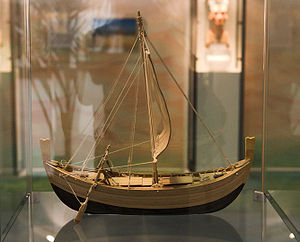Uluburun is Turkish for "Grand Cape" | |
 Wooden model of the ship's reconstruction | |
 | |
Site of the wreck 50 m (160 ft) off the eastern shore of Uluburun, and 6 mi (9.7 km) to the southeast of Kaş, Turkey | |
| Location | Uneven slope of the headland's shelf, 44 m (144 ft) to 52 m (171 ft) deep, with artifacts down to 61 m (200 ft) |
|---|---|
| Region | Bay of Antalya, off the Turquoise Coast. |
| Coordinates | 36°7′43″N 29°41′9″E / 36.12861°N 29.68583°E |
| Type | Site of a sunken ship |
| Length | About 10 m (33 ft) N-S, horizontal plot plan |
| Width | About 18 m (59 ft) E-W, horizontal plot-plan |
| Area | 180 m2 (1,900 sq ft), horizontal plot-plan |
| Height | Depth differential is 8 m (26 ft) vertical, with scattered artifacts, 17 m (56 ft) |
| History | |
| Builder | Unknown. The cargo was probably Mycenaean, deduced from the major type of ingot |
| Material | Wooden, single-mast, two-prow (stem, stern) sailing ship with one steering oar on a side |
| Founded | In use late 14th century BC; date obtained by dendrochronological dating |
| Abandoned | Sank late 14th century BC |
| Periods | Late Bronze Age |
| Cultures | Mycenaean, Cypriote, judging by the pottery |
| Associated with | Crew of the merchant vessel |
| Events | Collision with the headland, perhaps wind-driven |
| Site notes | |
| Excavation dates | Excavational dives directed by George Bass in 1984, and Cemal Pulak in 1985–1994 |
| Archaeologists | George F. Bass, Cemal Pulak |
| Condition | Conservation, sampling and study are ongoing |
| Ownership | Republic of Turkey |
| Management | Institute of Nautical Archaeology, an international organization |
| Public access | Objects may be viewed in the exhibit at the Bodrum Museum of Underwater Archaeology |
| Website | "Uluburun, Turkey". 23 February 2020. |
The Uluburun Shipwreck is a Late Bronze Age shipwreck dated to the late 14th century BC,[1] discovered close to the east shore of Uluburun (Grand Cape), Turkey, in the Mediterranean Sea.[2] The shipwreck was discovered in the summer of 1982 by Mehmed Çakir, a local sponge diver from Yalıkavak, a village near Bodrum.
Eleven consecutive campaigns of three to four months' duration took place from 1984 to 1994 totaling 22,413 dives, revealing one of the most spectacular Late Bronze Age assemblages to have emerged from the Mediterranean Sea.[3]
